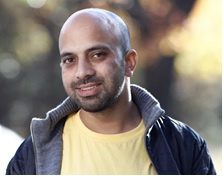
Assistant Professor
E-mail: anil dot thakur at rcb dot res dot in
Translational control of gene expression in yeast and fungal pathogens
Translational control plays an essential role in the regulation of gene expression. It is especially important in defining the proteome, maintaining homeostasis, controlling cell proliferation, growth, and development. Numerous disease states result from aberrant regulation of protein synthesis, therefore understanding the molecular basis and mechanisms of protein translation is critical. The protein synthesis machinery in higher eukaryotic organisms is much more complex than in prokaryotes. Our research is focused on understanding the translational regulatory mechanisms of protein synthesis in yeast and fungal pathogens. Initiation of translation at correct start codon in the mRNA is one of the first events in translation and it determines the reading frame to be decoded. In eukaryotic translation initiation, the 43S pre-initiation complex (PIC), containing initiator Met-tRNA in a ternary complex (TC) with the translation initiation factor 2 (eIF2) bound with GTP, scans the mRNA sequences for start codon in favourable context. However, little is known about the translatome employed by human fungal pathogens during infection.
In last couple of decades the patients with candidiasis has magnified, due to increase in immunocompromised cases that includes individuals suffering from AIDS, patients undergoing solid organ transplantation and chemotherapies. Candida species have high potential to cause life threatening systemic candidiasis in immunocompromised individuals. These pathogens can adapt to host microenvironment and penetrate through deep body tissues during systemic infection. Transcriptional profiling of fungal cells exposed to phagocytes have indicated major influences on ribosome biogenesis and protein synthesis. However the translational regulation that modulates the global translatome and specifically fine tunes the translation of mRNA subgroups for host adaptation or rescue from physiological stress conditions that are encountered during infection, needs to be thoroughly investigated. Our quest is to probe the translation process of pathogenic fungi and identify novel therapeutic targets to treat the fungal diseases in humans.
My lab focus is on two major objectives:
These studies will be performed on Saccharomyces cerevisiae, Candida albicans, Candida glabrata and Candida auris. We will use genetic, genomic, biochemical and molecular biology approaches to address these questions.
We are looking for enthusiastic candidates who would like to pursue their research career in translation and fungal pathogenesis. We welcome students for short-term training, six-months dissertation, project and PhD. We would be happy to accommodate for Post-Doctoral fellowships such as NPDF, DBT-RA.
Book Chapter:
Dr. Anil Thakur
Assistant Professor
Regional Centre for Biotechnology
NCR Biotech Science Cluster
3rd Milestone, Faridabad-Gurgaon Expressway
P.O. Box No. 3, Faridabad - 121 001
Haryana (NCR Delhi), India
e-mail: anil dot thakur at rcb dot res dot in
Phone: 91 0129-2848738